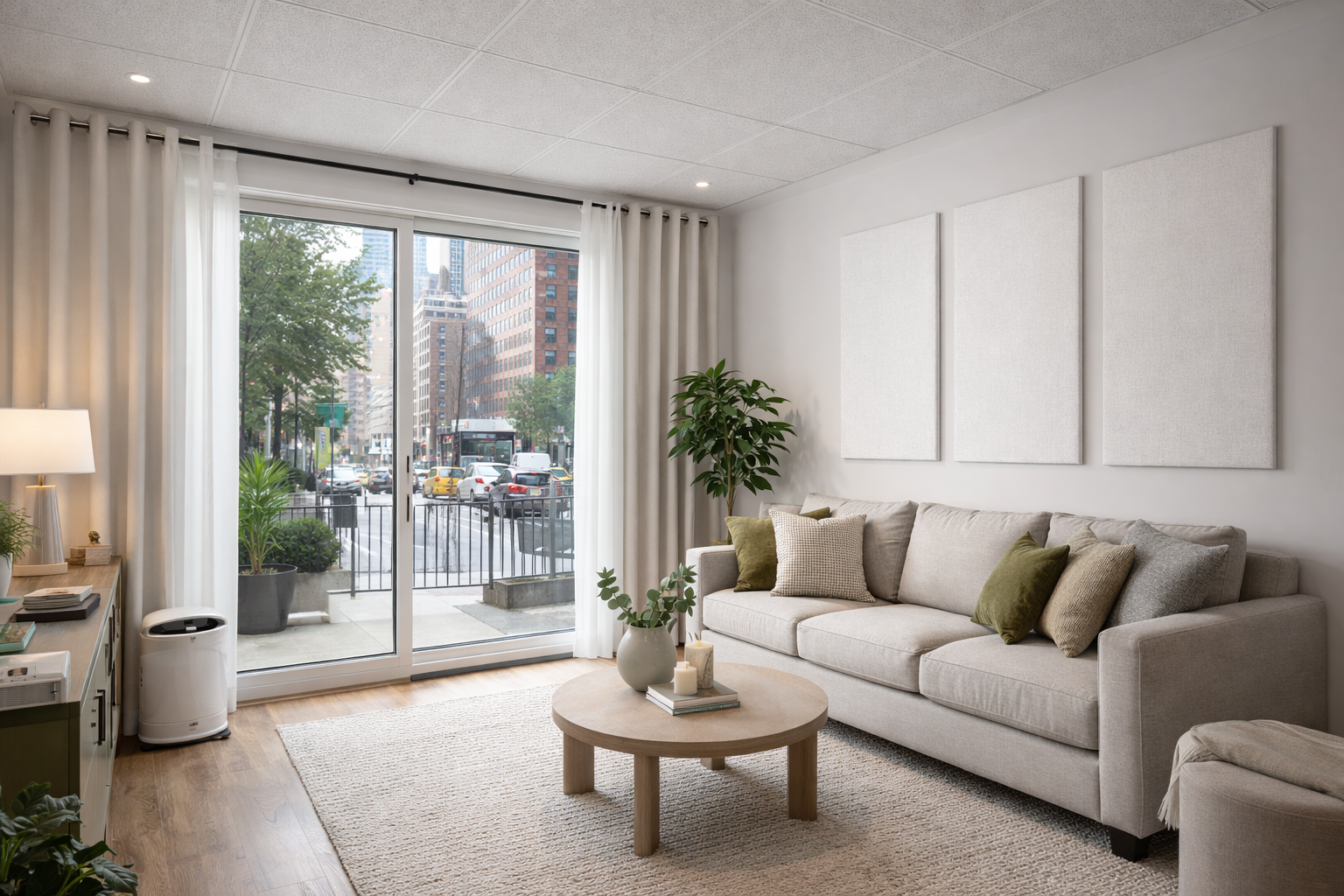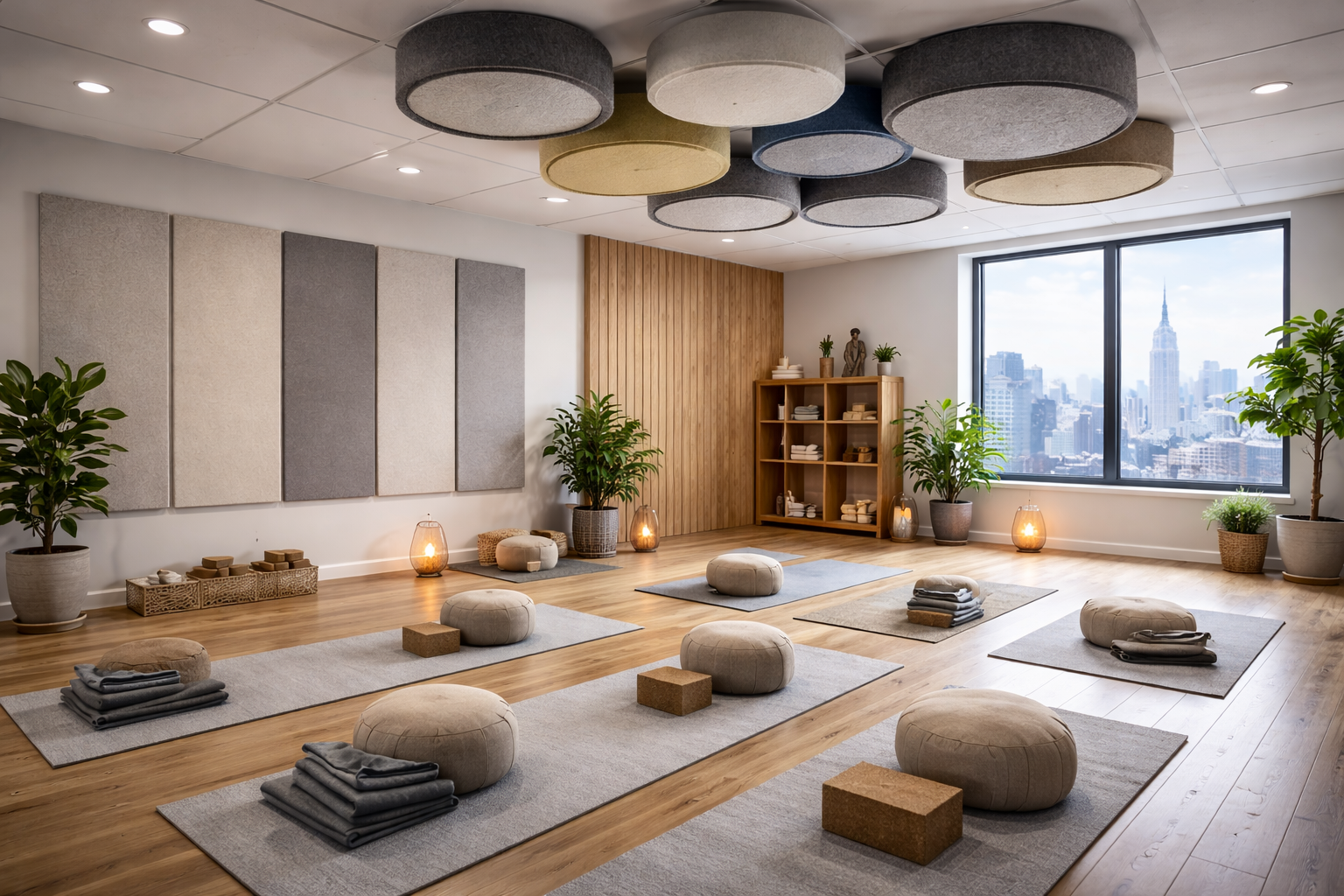What Are Acoustic Panels
You've seen them in recording studios, office conference rooms, classrooms, and maybe even modern restaurants - but what are acoustic panels, and why do they matter?
In short, acoustic panels are tools for controlling how sound behaves in a space. They're not just decorative. They serve a functional purpose: making rooms sound better by reducing unwanted echo, reverb, and noise buildup.
If you're asking what an acoustic panel is, you're likely trying to solve a real acoustic problem. This guide breaks it all down - materials, how they work, what they do, and where they're used - so you can make an informed choice for your space.
Understanding What an Acoustic Panel
Acoustic panels are more than just "soundproof wall pads." They're purpose-built sound treatment elements designed to absorb and manage sound waves inside a room.
Core Components and Materials Explained
At the core of every acoustic panel is a carefully selected combination of materials, each chosen for its specific acoustic function, safety, and visual integration.
|
Material |
Purpose |
|
Mineral Wool / Fiberglass |
High sound absorption across a wide frequency range. Ideal for professional-grade panels. |
|
Acoustic Foam |
Budget-friendly option. Common in DIY builds but less effective at low frequencies. |
|
Fabric Wrap |
Breathable, acoustically transparent fabric that lets sound pass through to the absorbent core. Available in custom colors and textures. |
|
Wood / Metal Frame |
Provides structure, rigidity, and mounting ease. Often used for clean, finished installations. |
|
Diffusion Layers (optional) |
Break up sound waves rather than absorb them. Used to preserve natural room tone while reducing echo. |
Each material plays a specific role in how the panel performs. Together, they create an acoustic solution that balances effectiveness, safety, and design flexibility.
Different Types of Acoustic Panel Construction
There's no single formula for building a panel. Designs vary depending on the space, purpose, and budget.
- Standard wall-mounted panels – rectangular, framed, and fabric-wrapped
- Ceiling-hung "cloud" panels – suspended horizontally to treat overhead reflections
- Bass traps – thicker panels for low-frequency absorption, usually corner-mounted
- Freestanding gobos – portable sound barriers for studios or open rooms
- Designer panels – custom shapes, printed graphics, or integrated lighting
Each construction type targets a different acoustic need. What works in a music studio might not fit in a boardroom. But they all start with the same idea: capture and convert sound energy before it becomes a problem.
How Acoustic Panels Differ from Regular Wall Coverings
Here's where the confusion usually starts: panels are not just fancy decorations. They're engineered for performance.
Regular wall coverings - paint, wallpaper, artwork - are reflective. They do nothing to manage sound. In fact, they often make the acoustic problem worse by adding more hard surfaces.
Acoustic panels, on the other hand, absorb energy from sound waves. They stop echoes, cut down reverb, and help define how a room feels and sounds. That's what separates a noisy, fatiguing space from one that feels calm and clear.
If you're wondering what are acoustic panels used for, the answer almost always involves creating acoustic comfort and control in ways that traditional design materials can't.
How Acoustic Panels Work
Now that we know what they are, let's get into how they function. Sound is physical energy—and acoustic panels are designed to interact with it.
Sound Wave Absorption vs Sound Reflection
When sound hits a hard surface, it reflects. That reflection creates echoes and amplifies noise in a room.
Acoustic panels solve this by using porous, soft materials that absorb the energy instead of reflecting it. The sound wave enters the panel, gets caught in the fibers, and gradually dissipates as heat. It's physics and it works.
This principle applies across panel types. Whether ceiling-mounted, freestanding, or wall-fixed, the goal is the same: reduce the amount of reflected sound bouncing around the space.
If you're still asking, how do sound panels work, it's all about that interaction between surface and wave.
Frequency Response and NRC Ratings
Not all panels absorb sound equally. The effectiveness of a panel is often described by its NRC (Noise Reduction Coefficient) rating.
This number ranges from 0.0 (no absorption) to 1.0 (perfect absorption). A panel with an NRC of 0.8 absorbs 80% of the sound energy that hits it, on average, across mid-range frequencies.
Panels with higher NRC values are typically thicker or made with denser core materials. These perform better at both low and high frequencies, making them ideal for complex acoustic environments like control rooms or conference halls.
Understanding NRC ratings is key to answering how sound-absorbing panels work in real-world applications.
Porous Materials and Sound Energy Conversion
Acoustic panels work best when made from porous materials. These allow sound waves to penetrate and get trapped inside, where friction breaks down the wave energy.
Materials like fiberglass and mineral wool excel at this. Foam works too, but usually only at mid-to-high frequencies.
This is where acoustic treatment differs from soundproofing. Soundproofing blocks sound from entering or exiting a space. Absorbing panels deal with sound inside the space.
If you're thinking about how to treat an echoey office or studio, this is your solution. You don't need to stop sound from leaving the room, you need to fix what's happening inside it.
What Do Acoustic Panels Do
So we've covered the what and the how. Now let's talk about the results. What do acoustic panels actually do once they're installed?
Echo and Reverberation Control
One of the primary goals of acoustic panels is to reduce echo and reverb. Echo is caused by sound bouncing off surfaces and returning to your ears milliseconds later. Reverb is a buildup of those overlapping reflections.
Acoustic panels cut this cycle short. By absorbing energy early in the sound's path, they prevent repeated reflections and let the original sound stand out more clearly.
This is why every professional studio uses them. But the benefits extend beyond music, acoustic clarity improves focus, productivity, and well-being in any space.
If you've ever walked into a room and thought it "sounded loud" even without people talking, you're hearing untreated reverb. Acoustic panels fix that fast.
Noise Level Reduction Benefits
Panels don't eliminate noise, but they reduce its impact. In open spaces, sound builds quickly. Footsteps, voices, machines they all add to the acoustic clutter.
By strategically placing absorption panels, you lower the overall perceived noise level. Conversations are clearer, distractions drop, and background hum fades away.
It's not about complete silence. It's about balance. Especially in open-plan offices or schools, this kind of acoustic management is essential for creating a healthy, usable environment.
People often ask how soundproof panels work, expecting silence. But what they really want is this: better control, less fatigue, and a cleaner soundscape.
Speech Intelligibility Improvements
One of the most overlooked benefits of acoustic panels is how much they help with speech clarity.
In spaces with lots of hard surfaces, words blur. Sentences bounce around the room, overlapping and becoming difficult to follow. This is a nightmare in classrooms, boardrooms, or video calls.
Panels reduce those reflections and make it easier for listeners to distinguish words. That's why they're essential in schools, hospitals, and meeting rooms, anywhere communication is key.
Wondering what acoustic panels do in a practical sense? They make sure what's said is actually heard.
How Do Soundproof Panels Work
Let's get one thing straight, soundproof panels and acoustic panels are not the same thing. This is where a lot of confusion starts.
Soundproofing is about blocking sound from passing through walls, ceilings, and floors. Acoustic panels are designed to absorb sound inside a room. The two can work together, but they serve different functions.
Sound Absorption vs Sound Blocking Explained
Sound absorption reduces internal reflections. It improves how a space sounds from the inside. Think better speech clarity, fewer echoes, and a lower sense of loudness.
Sound blocking, on the other hand, prevents sound from escaping or entering a space. It requires mass, isolation, and airtight barriers, not just foam or panels.
So when people ask, how do soundproof panels work, the answer depends on whether they mean soundproofing or acoustic treatment.
For real soundproofing, you need dense materials like mass-loaded vinyl, double walls with air gaps, or specialty construction techniques. You won't get there with regular absorption panels alone.
Mass Loaded vs Porous Panel Systems
Some hybrid panels combine both mass and porous cores. These panels offer modest sound-blocking performance while still absorbing reflections.
For example, a panel made from a heavy fiberboard core wrapped in mineral wool can offer some STC (Sound Transmission Class) benefits, while also improving NRC (Noise Reduction Coefficient).
But no matter how dense a panel is, if it's not installed with airtight isolation techniques, it won't truly stop noise from passing through. That's the key difference.
So, if you're trying to improve room acoustics, absorption panels are perfect. But if your goal is to block noise, say, from upstairs neighbors, you'll need more than panels.
Combining Absorption and Isolation Techniques
In many real-world projects, the best results come from layered strategies.
First, you isolate the structure—decoupling drywall, sealing gaps, and reinforcing floors or ceilings. Then, you apply acoustic treatment like panels or bass traps to handle internal reflections.
It's not one or the other. It's both.
In professional installations - studios, performance venues, even high-end home theaters - this hybrid approach creates acoustic clarity and noise isolation in one package.
For anyone asking how sound panels work in complex environments, this is the gold standard: absorption inside, isolation around.
What Are Acoustic Panels Used For Across Different Industries
Acoustic panels solve real problems across a wide range of industries. Here's how different spaces benefit from proper treatment.
Recording Studios and Music Production
Studios need clarity, control, and accuracy. Acoustic panels eliminate early reflections, absorb reverb, and create balanced listening zones.
From vocal booths to mixing rooms, panels help engineers hear the truth, not the room. Bass traps and ceiling clouds are also commonly used for full-spectrum control.
Whether it's a Grammy-winning space or a bedroom setup, acoustic treatment is non-negotiable.
Corporate Offices and Meeting Spaces
In offices, sound clarity drives productivity. Panels reduce echo in open areas, conference rooms, and shared workspaces. That leads to better focus, fewer distractions, and more effective communication.
They also help maintain speech privacy in executive offices or HR departments, a critical factor in modern hybrid workplaces.
Check out our office acoustics and design section to see real-world results.
Educational Facilities and Auditoriums
In schools and auditoriums, untreated acoustics can ruin the learning experience. Students can't focus if they can't hear clearly.
Panels help reduce crowd noise, echo from hard walls, and sound bleed between classrooms. In auditoriums, ceiling baffles and wall panels work together to make speech intelligible and performances crisp.
Healthcare and Hospitality Applications
Hospitals and hotels rely on acoustic comfort. In healthcare, panels reduce stress, improve sleep, and help maintain privacy in patient rooms.
In hotels, good sound design increases guest satisfaction, especially in lobbies, restaurants, and shared spaces.
Custom-fabric panels are ideal here because they absorb sound without compromising on aesthetics or hygiene requirements.
Selecting the Right Acoustic Panel System
Choosing the right acoustic panel system isn't about picking something off the shelf, it's about matching the product to your specific space and goals. There are four key factors to consider when making that decision.
First, think about your environment. Is it a recording studio that needs tight sound control across all frequencies? An open office struggling with echo? A classroom where speech clarity is critical? Or a residential space where comfort and aesthetics matter? Each setting demands a different approach.
Second, clarify your goal. Are you trying to absorb sound within the room, block noise from traveling between spaces, or achieve a combination of both? This determines whether you need soft, porous panels, dense soundproofing layers, or a hybrid solution.
Third, assess your design constraints. Consider your budget, available wall or ceiling space, ceiling height, and visual style. Acoustic panels can be customized to fit any layout—but knowing your limits helps shape the most effective plan.
Fourth, understand your performance needs. Are you dealing with high-pitched echoes or low-end rumble? Identifying the specific frequency issues in your room will help determine the right panel thickness, placement, and materials.
A studio might need full-spectrum coverage, including bass traps and ceiling clouds. An office may only need strategically placed wall panels to reduce harsh reflections. In a hotel lobby, the priority may be elegant, integrated treatment that doesn't distract from the design.
At New York Soundproofing, we guide clients through every step - testing, layout, product selection, and installation. We don't just sell acoustic panels. We create solutions that sound as good as they look.
.png)


